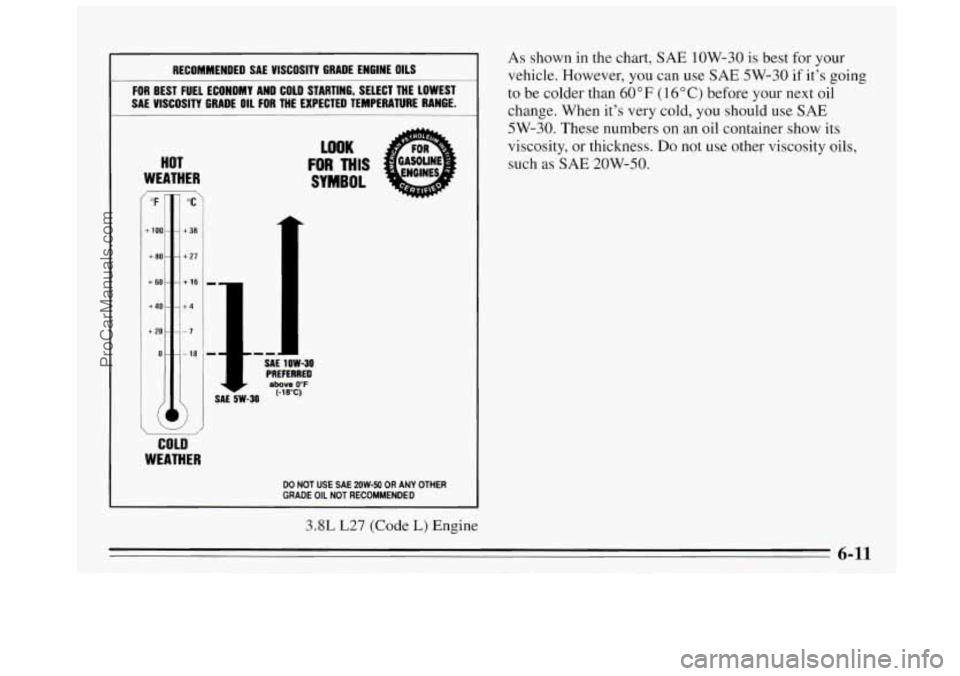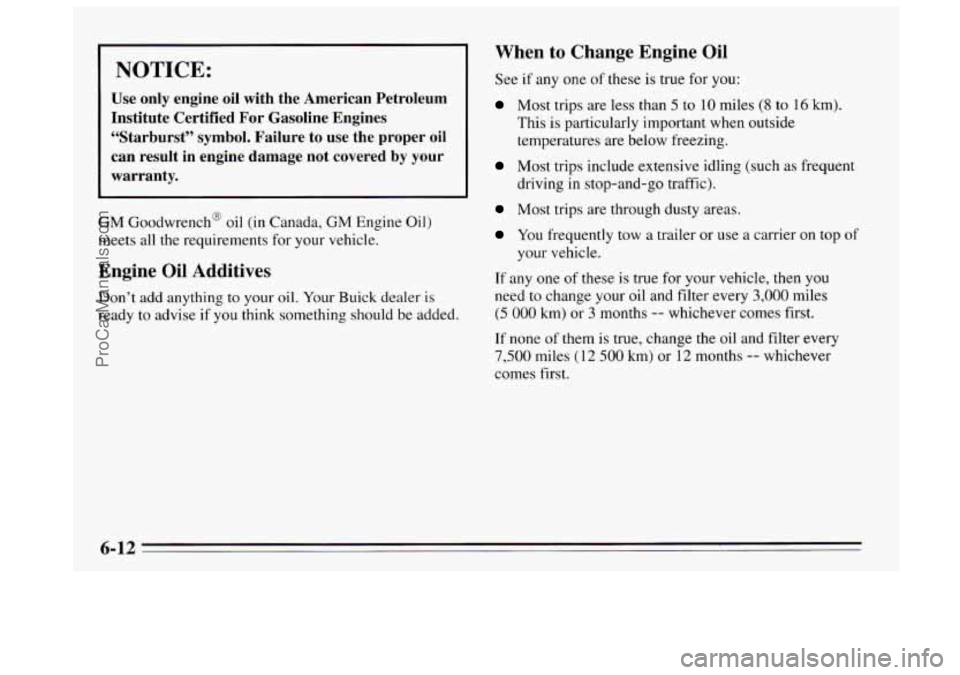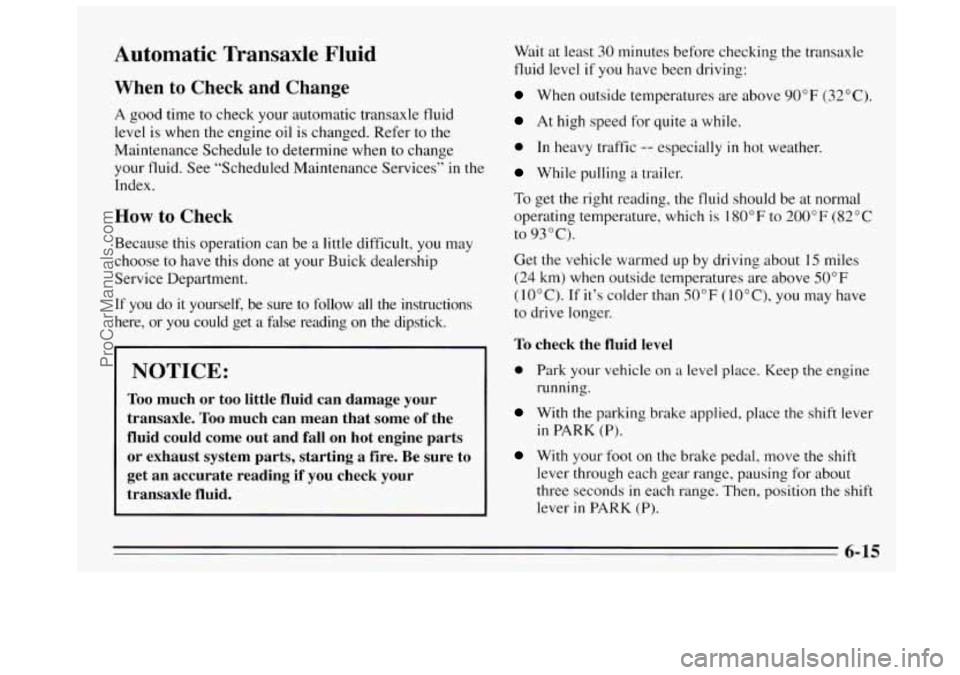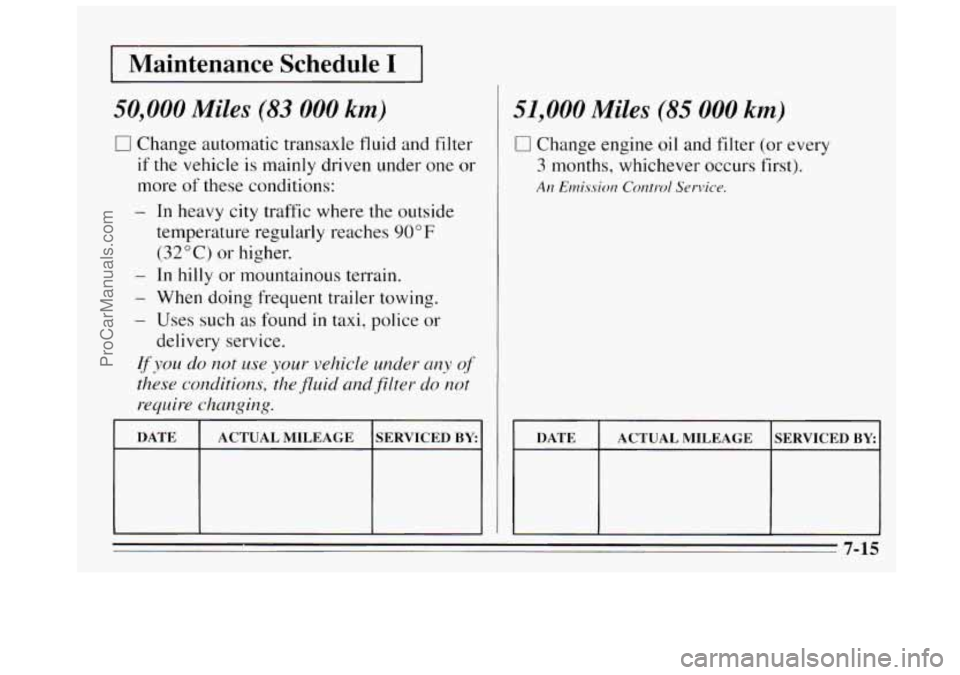1995 BUICK REGAL oil temperature
[x] Cancel search: oil temperaturePage 218 of 340

What Kind of Oil to Use
Oils of the proper quality for your vehicle can be
identified by looking for the “Starburst” symbol. The
“Starburst” symbol indicates that the oil has been
certified by the American Petroleum Institute (API), and
is preferred for use in your gasoline engine.
If you change your own oil,
be sure you use oil that has
the “Starburst” symbol on
the front of the oil
container.
If you have your
oil changed for you, be sure
the oil put into your engine
is American Petroleum
Institute certified for
gasoline engines.
You should also use the proper viscosity oil for your
vehicle, as shown in the following chart:
As shown in the chart, SAE 5W-30 is best for your
vehicle. However, you can use SAE 1OW-30 if it’s going
to be
0°F (- 18°C) or above. These numbers on an oil
container show its viscosity, or thickness.
Do not use
other viscosity oils, such as SAE
20W-50.
RECOMMENDED SAE VISCOSITY GRADE ENGINE OILS ~~~~~ ~ ~ ~~ ~~~
FOR BEST FUEL ECONOMY AND COLD STARTING, SELECT THE LOWEST
SAE VISCOSITY GRADE OIL
FOR THE EXPECTED TEMPERATURE RANGE.
HOT
WEATHER
COLD
WEATHER
FOR THIS
LOOK
SYMBOL @&
SAE 1OW-30
r
RED
DO NOT USE SAE 2OW-50 OR ANY OTHER
GRADE OIL NOT RECOMMENDED
3.1L L82 (Code M) Engine
6-10
~
ProCarManuals.com
Page 219 of 340

RECOMMENDED SAE VISCOSITY GRADE ENGINE OILS
FOR BEST FUEL ECONOMY AND COLD STARTING, SELECT THE LOWEST
SAL VISCOSITY GRADE
OIL FOR THE EXPECTED TEMPERATURE RANGE. -
HOT
WEATHER
- "F "C
-100- - +38
+BO- - +27
+60--+16
+40--+4
+20---7
0---18
SAL SW-30
LOOK
FOR THIS
SYMBOL
SAE 1OW-30 PREFERRE0 above 0°F (-18OC)
COLD
WEATHER
DO NOT USE SAE 2OW-50 OR ANY OTHER
GRADE OIL NOT RECOMMENDED
3.8L L27 (Code L) Engine
As shown in the chart, SAE 1OW-30 is best for your
vehicle. However, you can use
SAE 5W-30 if it's going
to be colder than
60°F ( 16" C) before your next oil
change. When it's very cold, you should use
SAE
5W-30. These numbers on an oil container show its
viscosity, or thickness.
Do not use other viscosity oils,
such as
SAE 20W-50.
6-11
ProCarManuals.com
Page 220 of 340

When to Change Engine Oil
See if any one of these is true for you: NOTICE:
Use only engine oil with the American Petroleum
Institute Certified For Gasoline Engines
“Starburst” symbol. Failure to use the proper oil
can result
in engine damage not covered by your
warranty.
Most trips are less than 5 to 10 miles (8 to 16 km).
This
is particularly important when outside
temperatures are below freezing.
Most trips include extensive idling (such as frequent
driving
in stop-and-go traffic).
GM Goodwrench@ oil (in Canada, GM Engine Oil)
meets all the requirements for your vehicle.
Engine Oil Additives
Don’t add anything to your oil. Your Buick dealer is
ready to advise if you think something should be added.
Most trips are through dusty areas.
You frequently tow a trailer or use a carrier on top of
your vehicle.
Tf any one of these is true for your vehicle, then you
need to change your oil and filter every
3,000 miles
(5 000 km) or 3 months -- whichever comes first.
If none of them is true, change the oil and filter every
7,500 miles (12 500 km) or 12 months -- whichever
comes first.
6-12
ProCarManuals.com
Page 223 of 340

Automatic Transaxle Fluid
When to Check and Change
A good time to check your automatic transaxle fluid
level is when the engine oil is changed. Refer to the
Maintenance Schedule
to determine when to change
your fluid. See “Scheduled Maintenance Services” in
the
Index.
How to Check
Because this operation can be a little difficult, you may
choose to have this done at your Buick dealership
Service Department.
If you do it yourself, be sure
to follow all the instructions
here, or you could get
a false reading on the dipstick.
NOTICE:
Too much or too little fluid can damage your
transaxle.
Too much can mean that some of the
fluid could come out and fall on hot engine parts or exhaust system parts, starting a fire. Be sure to
get an accurate reading if you check your
transaxle fluid.
Wait at least 30 minutes before checking the transaxle
fluid level
if you have been driving:
When outside temperatures are above 90°F (32°C).
At high speed for quite a while.
0 In heavy traffic -- especially in hot weather.
While pulling a trailer.
To get the right reading, the fluid should be at normal
operating temperature, which is
180°F to 200°F (82°C
to
93 ” C).
Get the vehicle warmed up by driving about 15 miles
(24
km) when outside temperatures are above 50°F
(10°C). If it’s colder than 50°F (IOOC), you may have
to drive longer.
To check the fluid level
0 Park your vehicle on a level place. Keep the engine
running.
With the parking brake applied, place the shift lever
in PARK (P).
With your foot on the brake pedal, move the shift
lever through each gear range, pausing for about
three seconds
in each range. Then, position the shift
lever
in PARK (P).
6-15
ProCarManuals.com
Page 225 of 340

How to Add Fluid
Refer to the Maintenance Schedule to determine what
kind of transaxle fluid to use. See “Recommended
Fluids and Lubricants”
in the Index.
If the fluid level is low, add only enough of the proper
fluid to bring the level into the cross-hatched area on the
dipstick.
1. Pull out the dipstick.
2. Using a long-neck funnel, add enough fluid at the
dipstick hole
to bring it to the proper level.
It doesn’t take much fluid, generally less than a pint
(OSL). Don ’t ouefill. We recommend you use only fluid
labeled DEXRON@-111, because fluid with that label is
made especially for your automatic transaxle. Damage
caused by fluid other than DEXRON@-I11 is not covered
by your new vehicle warranty.
After adding fluid, recheck the fluid level as
described under “How
to Check.”
When the correct fluid level is obtained, push the
dipstick back in all the way.
Engine Coolant
The following explains your cooling system and how to
add coolant when it is low. If you have a problem with
engine overheating or if
you need to add coolant to your
radiator, see “Engine Overheating” in the Index.
The proper coolant for your Buick will:
Give freezing protection down to -34°F (-37°C).
Give boiling protection up to 262 OF (1 28 O C).
Protect against rust and corrosion.
Help keep the proper engine temperature.
Let the warning lights work as they should.
What to Use
Use a mixture of one-half clean water (preferably
distilled) and one-half antifreeze that meets “GM
Specification
1825-M,” which won’t damage aluminum
parts. You can also use a recycled coolant conforming to
GM Specification 1825-M with a complete coolant flush
and refill. Use GM Engine Coolant Supplement (sealer)
with any complete coolant flush and refill.
If you use
this mixture, you don’t need to add anything else.
~
6-17
ProCarManuals.com
Page 263 of 340

Capacities and Specifications
Automatic Transaxle
Pan Removal and Replacement ....... 7 quarts (6.7 L)
When drainingheplacing converteq more fluid muy be
needed.
Cooling System Including Reservoir
3. IL (Code M) ................ 11.6 quarts (10.93 L)
3.8L (Code L) ................. 10.7 quarts (10.1 L)
Engine Specifications ..............................
Type ............................................
Displacement .....................................
Compression Ratio .................................
Firing Order ......................................
Thermostat Temperature ............................
ValveArrangement ................................
Refrigerant (R-l34a), Air Conditioning*
Engine Crankcase Oil
and Filter Change .............. 5 quarts (4.7 L)
Fuel Tank ..................... 17.1 gallons (64.7 L)
*See “Air Conditioning Rejrigerunts” later irz this
section.
.............................. 2.0 pounds (0.91 kg)
3.1L (Code M)
V6
191 CID (3.1L)
9.6:
1
1-2-3-4-5-6
195°F (91OC)
In-Head
3.8L (Code L)
V6
231 CID (3.8L)
9.0: I
1-2-3-4-5-6
195°F (91
“C)
In-Head
6-55
ProCarManuals.com
Page 272 of 340

Maintenance Schedule
I Schedule I Definition I
Follow Maintenance Schedule I if any one of these is
true for your vehicle:
Most trips are less than 5 to IO miles (8 to 16 kin).
This is particularly important when outside
temperatures are below freezing.
Most trips include extensive idling (such as frequent
driving
in stop-and-go traffic).
Most trips are through dusty areas.
You frequently tow a trailer or use a can-ier on top of
your vehicle.
Schedule
1 should also be followed if the vehicle is used
for delivery service, police, taxi, or other commercial
application.
Schedule I Intervals
Every 3,000 Miles (5 000 knl) or 3 Months,
Whichever Occurs First
Every 6,000 Miles (10 000 km) or
6 months,
Whichever Occurs First
Chassis Lubrication
At 6,000 Miles ( 10 000 km) - Then Every
12,000 Miles
(25 000 km)
Tire Rotation
Every 15,000 Miles (25 000 km)
Air Cleaner Filter Inspection, if driving in dusty conditions
Every 30,000 Miles (50 000 kin)
Air Cleaner Filter Replacement
Spark Plug Replacement
Spark Plug Wire Inspection
Fuel Tank, Cap and Lines Inspection
Engine Accessory Drive Belt Inspection
(or every
24 months, whichever occurs first)
Cooling System Service
(or every 24 months,
whichever occurs first)
Automatic T~-ansaxle Service (severe conditions only)
Engine
Oil and Filter Change
Every 50,000 Miles (83 000 km)
7-4
ProCarManuals.com
Page 283 of 340

I Maintenance Schedule I I
50,000 Miles (83 000 km)
0 Change automatic transaxle fluid and filter
if the vehicle is mainly driven under one or
more of these conditions:
- In heavy city traffic where the outside
temperature regularly reaches
90 O F
(32°C) or higher.
- In hilly or mountainous terrain.
- When doing frequent trailer towing.
- Uses such as found in taxi, police or
[fyou CEO not use your vehicle under uny ”. of
these conditions, &$uicl and jiltev do not
require changing.
DATE
ACTUAL MILEAGE
SERVICED BY
delivery service.
51,000 Miles (85 000 km)
0 Change engine oil and filter (or every
3 months, whichever occurs first).
AI? Emission ContmI Servi(v.
DATE
SERVICED BY ACTUAL MILEAGE
7-15
ProCarManuals.com